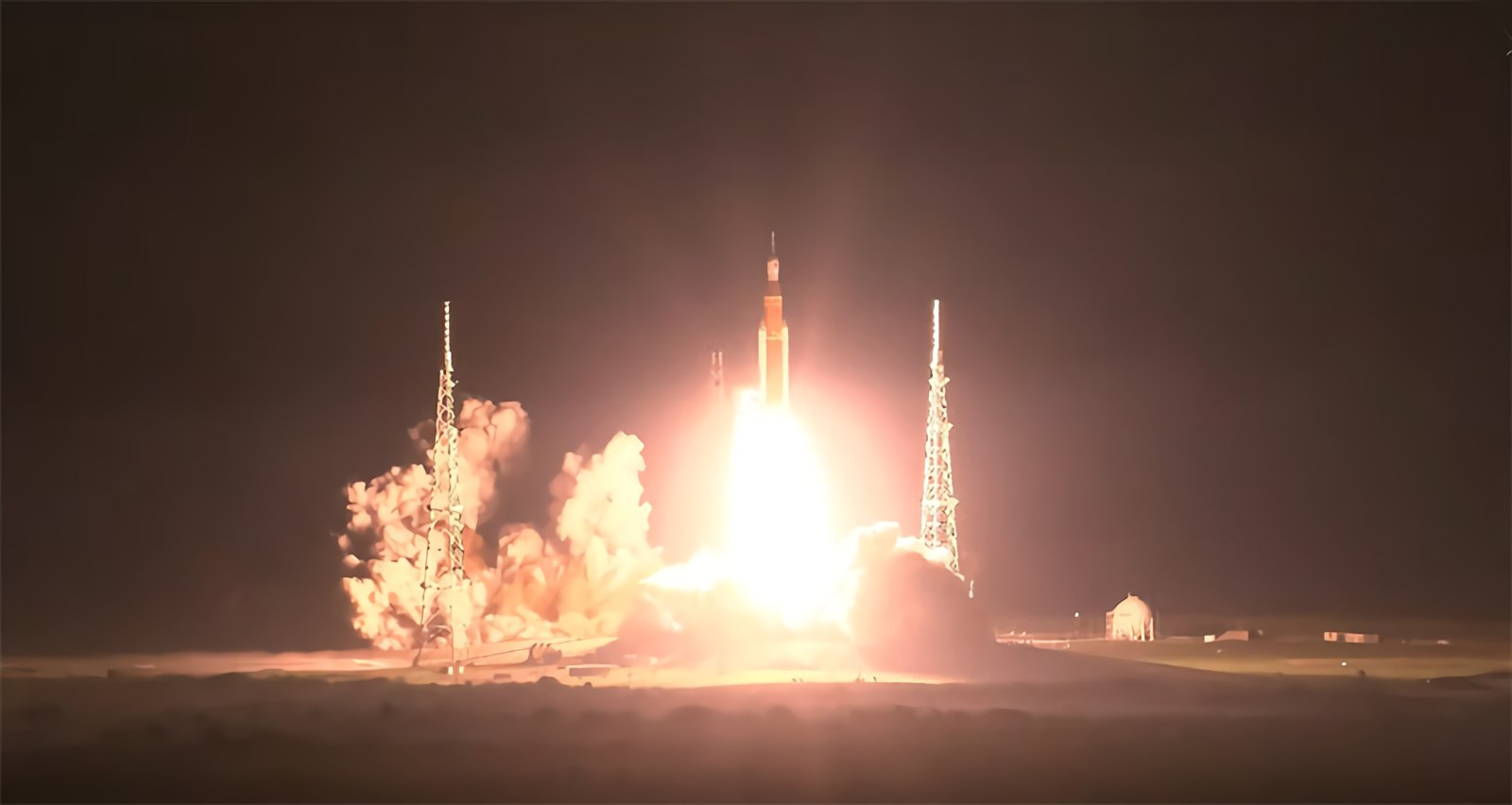What is the DART mission? Here is everything there is to know about it. Thousands upon thousands of asteroids speed through space with many of them routinely passing within Earth’s orbit. A regional or perhaps worldwide disaster could be triggered if one of them were to arrive on a collision track with Earth. With its DART mission, NASA is exploring whether or not this may be avoided; for the first time, humankind will seek to alter an asteroid’s course by use of a ram probe.
What could be done if an asteroid is headed in the direction of Earth? According to NASA, a more effective defense would be to use an unmanned spacecraft to deflect the asteroid. On September 26, 2022, NASA’s DART mission will put this kinetic deflector approach to the test.
How do you avoid an asteroid collision?

The risk is real: Earth has been bombarded by space debris several times during its existence. The impact of the 6.2-mile (10-kilometer) wide Chicxulub asteroid 66 million years ago terminated the Cretaceous epoch and wiped out the dinosaurs, while other impacts have created worldwide disasters and monumental mass extinctions. The Tunguska event of 1908 and the Chelyabinsk meteor explosion in February 2013 proved, however, that even tiny fragments may wreak devastating harm.
About 25,000 asteroids, each about 500 feet (150 meters) in size, orbit in the neighborhood of the Earth and often pass through the Earth’s orbit. Although many incidents still go unreported.
It’s just a matter of time
Small chunks up to 3.3 feet (1 meter) in size continue to impact Earth practically daily but are burned up in the atmosphere before reaching the surface. Asteroids up to 1,000 feet (300 meters) in size are expected to strike every few thousand years, and asteroids the size of the Chelyabinsk meteor are seen on average once every 50 years. They are big enough to obliterate a whole city of millions. It’s not a matter of if, but rather when, the next major impact on Earth will occur.
What could be done if an oncoming asteroid is noticed in time? Whether humanity still has time to adopt countermeasures for an approaching asteroid depends on the size of the asteroid and the time left before the impact. When the threat is known decades in advance, the “gentle” “Gravity Tractor” defense could be all that’s needed: Using the gravitational pull of a large probe brought in close proximity to the asteroid, you can divert the asteroid off an Earth collision trajectory.
The kinetic deflector

But in reality, it is more probable that the asteroid will go undetected until it is too late. Because many possible Earth-orbiting asteroids are hard to spot in advance due to their dimness and their orbital distance to the Sun. The 330-foot (100-meter) asteroid called “2019 OK,” for example, was only discovered 12 hours before its closest approach in 2019. Thankfully, it was passing Earth at a distance of barely one-fifth that of the moon. After that point, no amount of protective measures will be able to prevent an impact.
However, there is still hope for an asteroid deflection if an asteroid on a crash track is discovered months or perhaps years in advance. The kinetic deflector approach is generally thought to be the best in such a scenario. As part of the strategy, the heaviest feasible spacecraft is sent in the direction of the asteroid to smash it at a specific angle. If the collision happens early enough, the force of the impact can deviate the fragment off its trajectory, and a deviation of only a few millimeters or a modest slowing is enough to prevent a collision with Earth.
But there is more to it
However, such a deflection is notoriously difficult in reality. The asteroid probe has to make a perfectly timed and hard collision with the asteroid. Too much of an off-angle impact will just alter the asteroid’s spin and not its course. The deflecting impact will be insufficient if the momentum is too low. This method requires the most precise data available regarding the asteroid’s course, spin, and size in order to precisely plan the collision.
If the asteroid is porous, most of the impactor’s energy might be absorbed instead of dissipated. The spacecraft’s collision might cause the asteroid to fracture if it is fragile or made of debris that is only weakly held together. Multiple, potentially catastrophic chunks can still head toward Earth in this case.
Given these challenges, NASA is conducting its first practical tests of kinetic deflection, called the DART Project, as a means of asteroid deflection, serving as a kind of “dress rehearsal” for the real deal.
Target object of the DART
A double asteroid as the impactor
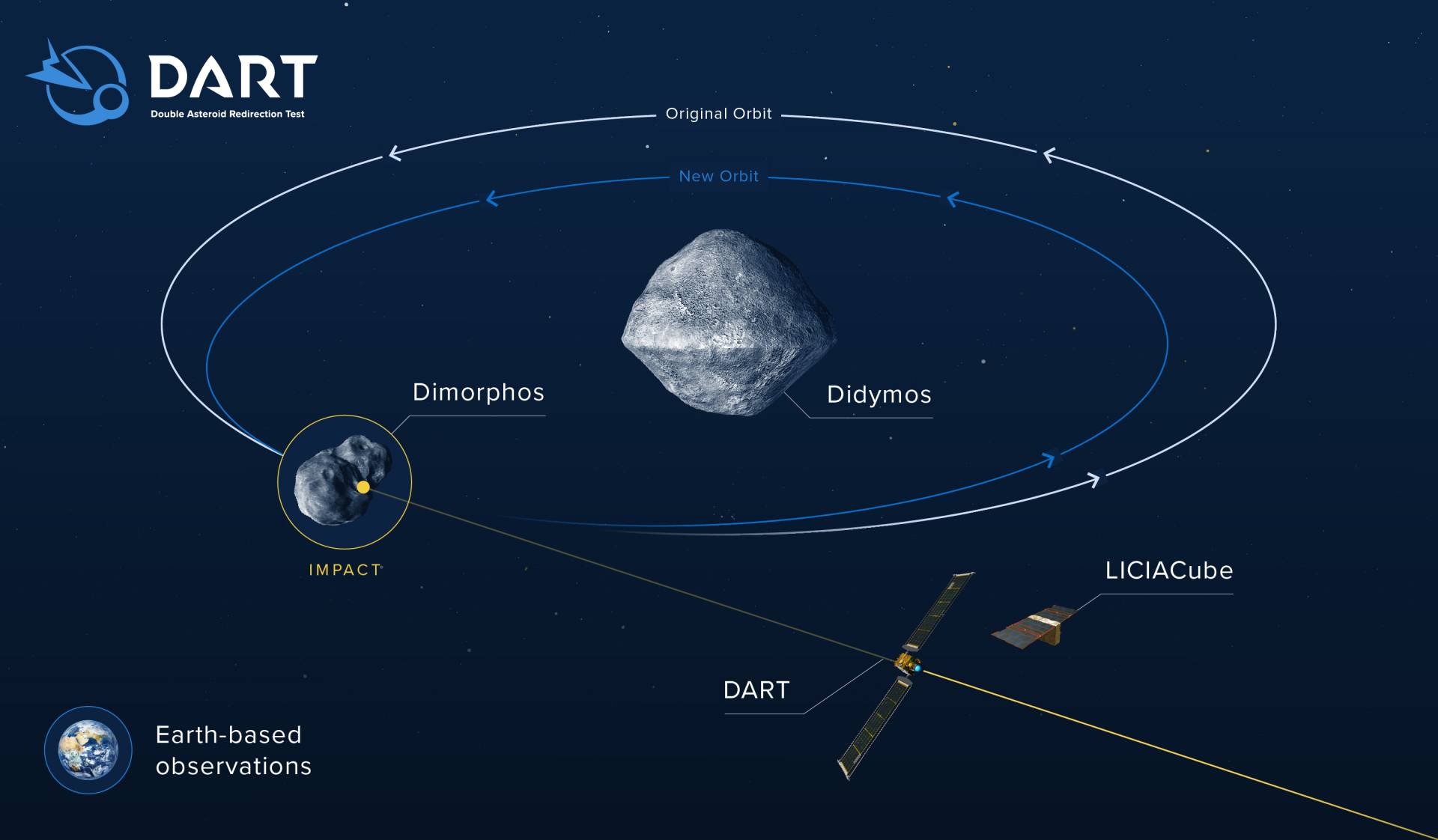
This is no easy feat since the whole collision must take place millions of miles from Earth to redirect an asteroid off its crash course with Earth. However, if the asteroid is so far away, the scientists may not be able to determine its exact nature, rotation, or mass before sending out the defensive probe since it will be beyond the precision of current Earth-based telescopes.
The selection of the test asteroid for DART
With the “Double Asteroid Redirection Test,” or DART, NASA is exploring the limits of an asteroid defense mission’s success and the hazards it faces. If an asteroid were to be headed toward Earth, a kinetic deflector, like the one shown by DART, would be the only way to stop it. DART’s mission is to change an asteroid’s orbit, so it can not collide with Earth.
The primary stipulation for the DART is that the experiment must not endanger Earth in any way. Even after an unsuccessful deflection, the target asteroid must follow a course that moves it as far away from Earth as feasible. However, in order to accurately assess the ramming’s effects, the candidate asteroid must be rather near. Thus, it has to be visible with large telescopes.
Didymos and its moon Dimorphos
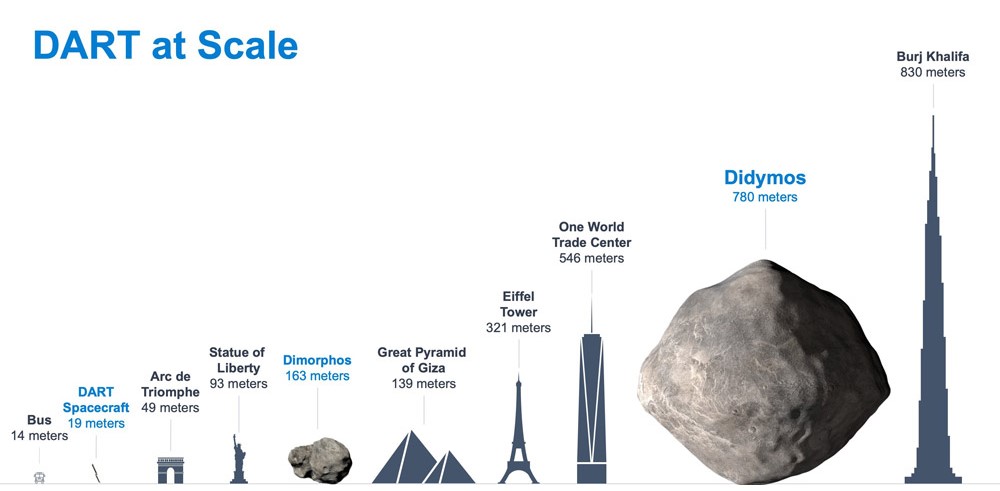
The 1996-discovered twin asteroid Didymos satisfies these requirements for the DART mission. Didymos, the 2560-foot (780-meter) asteroid, and Dimorphos, its moon, measure around 525 feet (160 meters) in diameter. Because of their eccentric orbits, they both swing from the furthest distance from the Sun outside of Mars’ orbit to the closest distance to the Sun within Earth’s orbit. Accordingly, both are circling the Earth and are part of the class of asteroids that, although not immediately dangerous, may one day approach Earth.
This is also why the DART mission isn’t actually aimed at the asteroid Didymos itself. Because there’s too much of a chance that the asteroid may be redirected in such a manner that it would eventually crash on Earth. The moon of the asteroid Dimorphos (Greek for “two forms”) is the actual target of the DART. Due to the stability of its orbit around Didymos, any deviation will only alter the minor-planet moon’s path relative to Didymos.
Observing Dimorphos with transits
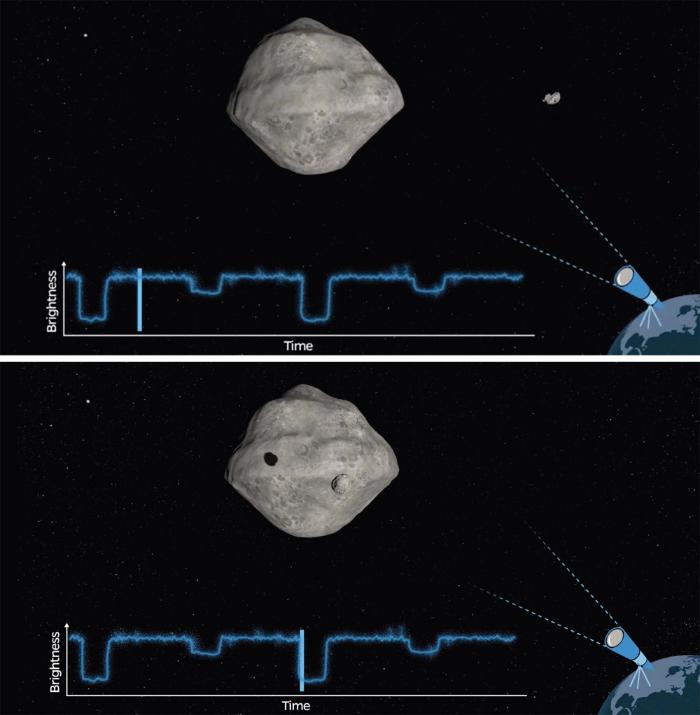
While in orbit around Didymos, the asteroid moon also travels directly in front of it. Due to this predictable transit, astronomers have been able to estimate Dimorphos’ orbit and size using just Earth-based telescopes. This tiny moon takes 11 hours and 55 minutes to complete one orbit around its parent asteroid. During this time, the distance between them stays at just approximately 0.73 miles (1.18 kilometers).
The DART mission’s before-and-after planning requires a high level of foreknowledge about the asteroid system. Dimorphos’ orbit around its parent asteroid may be significantly altered if the DART probe collides with the moon at just the proper location and velocity. This deflection, at least in the model predictions, is expected to become apparent during the transit phase. As a result of the impact made by DART on the smaller asteroid in the Didymos system, its orbital period will be altered by at least 73 seconds.
The Didymos-Dimorphos binary asteroids will be within observing distance of Earth at the time of the DART’s collision on September 26, 2022, at a distance of just around 6.85 million miles (11 million kilometers).
Almost indistinguishable from the actual threat
However, there is a second reason why the Didymos system is well suited as a test case for the DART: its two components are illustrative of prospective asteroid impactors on Earth’s course. Dimorphos, with a diameter of around 540 feet (165 meters), is huge enough to cause widespread destruction in the case of an impact on Earth. While its size is comparable to that of probable next-catastrophic-impact asteroids, it is not one of them.
The composition of the target asteroid of the DART mission is also quite similar to that of the asteroids that are flying close to Earth. Didymos’s composition matches that of an “L/LL chondrite” meteorite class according to the analysis of its visible and near-infrared spectra. And this is the composition of most meteorites that strike Earth. The experimental findings of the DART collision will be used for a wide variety of planetary defense research.
Order of events of the DART mission
Specifications of the DART spacecraft
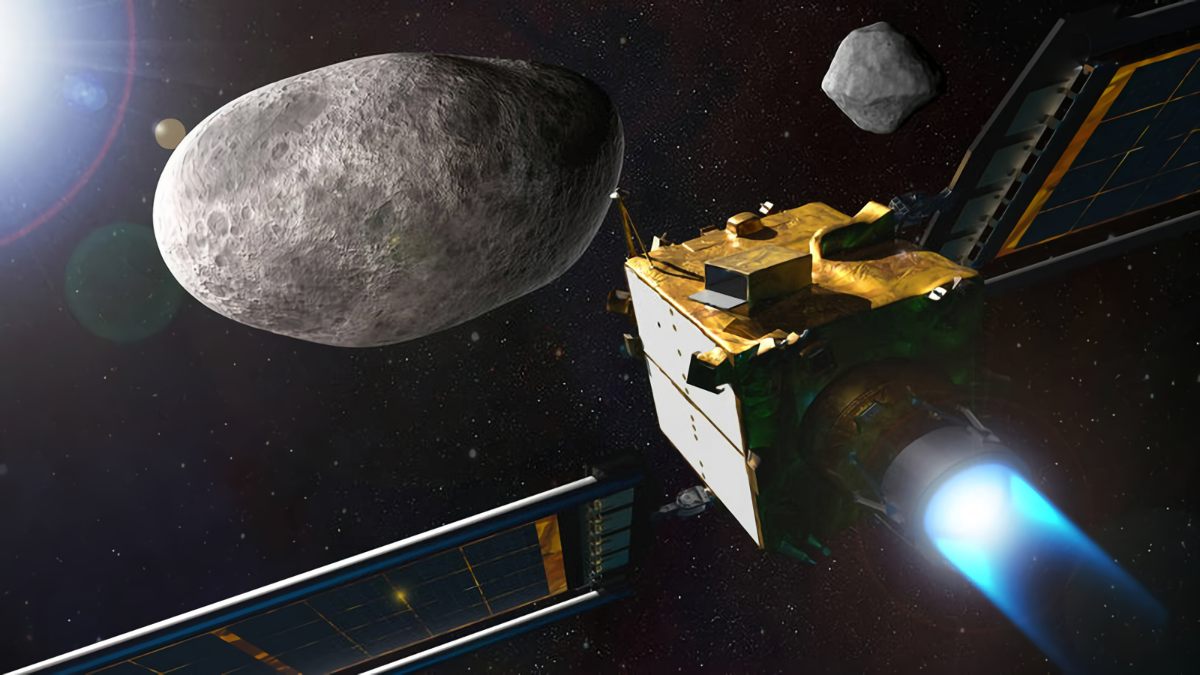
The DART spacecraft has been traveling toward the asteroid Dimorphos since it was launched on November 24, 2021. The asteroid moon Dimorphos will be rammed by the spacecraft on September 26, 2022, at 23:14 UTC, in an attempt to knock it out of orbit. This will be the first-ever test of a technology designed to protect Earth from asteroids. The DART mission is outfitted with various high-tech enhancements that allow this to happen.
The impactor probe used in the DART mission seems plain at first glance: The dimensions of its hull are 3.9 by 4.3 feet (1.2 by 1.3 meters), making it about the size of a soda machine. During the roughly 10-month approach, the DART probe has been powered by two solar panels, each of which is a good 26 feet (8 meters) in length. An experimental ion drive generates thrust by electrostatically accelerating and ejecting xenon ions in a magnetic field. DART has 12 hydrazine-fueled classical maneuvering thrusters for course corrections and fine-tuning of the final approach to Dimorphos.
DART’s autonomous target acquisition and approach
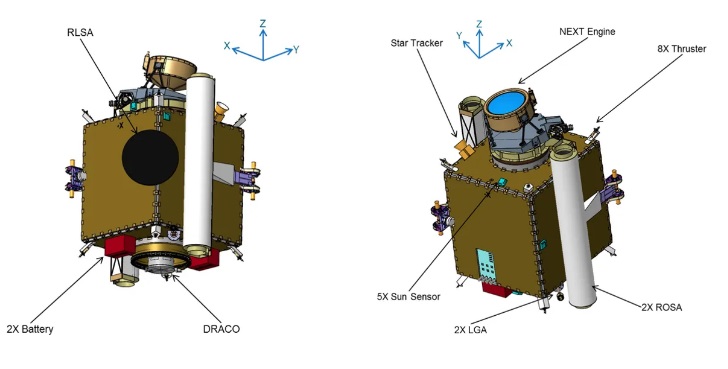
The DART probe has a navigation system that is considerably sophisticated. This is due to DART’s ability to fine-tune its trajectory on its own. The data from the DRACO camera, a tiny telescope with a focal length of around 8.3 inches (21 cm), and a high-resolution digital image sensor are placed on DART for this purpose. High-resolution photos captured by the camera will reveal the precise location and shape of Didymos and Dimorphos.
The spacecraft’s autonomous navigation system records these photos with location and attitude data. About 4 hours before the crash with Dimorphos, at a distance of 56,000 miles (90,000 kilometers) from the target, this SMART Nav system will assume complete control of the DART probe. The navigation system will initially perform an evaluation of the data in order to pinpoint the precise locations of Didymos and its moon Dimorphos using custom algorithms. An hour before impact, Dimorphos will appear as a small 1.5-pixel light point.
The navigation system will then be able to make autonomous decisions about whether or not trajectory modifications are required, and the DART probe’s correction jets will receive new commands. When there are only 930 miles (1,500 kilometers) left between Dimorphos and DART, the asteroid in DRACO images will be around 22 pixels in size and it will be too late for DART to make any changes at this point. When DART is around 460 miles (740 kilometers) away from the target, it will be on a collision track with Dimorphos in two minutes. The probe will now just cover the rest of the distance.
The impact
The DART probe will crash on the surface of Dimorphos at a speed of around 14,000 miles (22,000 kilometers) per hour. DART weighs only 1,260 pounds (570 kilos), whereas the asteroid moon Dimorphos is predicted to weigh over 11 billion pounds (5 billion kilograms). Therefore their collision is more like a bug landing on an elephant. The impact’s relatively small impulse might not seem like it would accomplish anything.
This, however, is not true. The 540 feet (165-meter) rock will receive a little push from the high velocity of the DART collision. In addition to blasting between ten thousand and a hundred thousand pounds of debris into space, the impact will also create a hole in the asteroid’s surface. The force exerted on Dimorphos will be greater than that of the hit alone because of the rebound of this ejection. The combination of this amplified ramming action and the collision is enough to cause a little shift in the asteroid moon’s kinetic energy and knock it off of its orbit.
After DART crashed onto Dimorphos, the spacecraft will be destroyed but the scientific investigation will only be getting started.
Consequences of the DART Impact Event
What will happen to the massive Dimorphos-moon once the tiny DART spacecraft crashes into it? Will the massive asteroid be able to be steered out of orbit by kinetic deflection? How did scientists successfully predict the collision characteristics of the DART-Dimorphos event essential for a deflection?
LICIACube as the direct observer
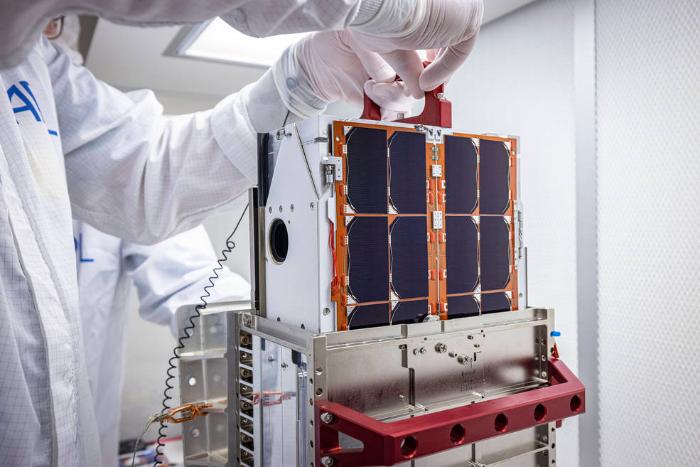
The LICIACube mini-satellite will report back the first data on the DART’s impact results and its effects on Dimorphos’s surface. This mini-satellite will ride behind the DART probe before it collides with the Didymos double asteroid, and its mission is to check out the impact area. Self-propelled with its maneuvering thrusters, it’s programmed to move into an observation point 15 days before the collision, which has already been initiated on September 11th.
LICIACube stands for Light Italian CubeSat for Imaging Asteroids. And the observations and documentation from this courageous little reporter will provide insights scientists couldn’t gain any other way. Using two optical cameras, LICIACube will capture the moment the DART spacecraft crashes on the surface of Dimorphos. Three minutes after the impact, LICIACube will adjust its course to fly near the DART’s crash location.
Images of the crater, the ejected material, and the type of debris of the DART impact are to be provided by this mini-probe. These photographs, together with the last close-ups captured by DART’s DRACO camera before the collision, will provide crucial details regarding the Dimorphos’ make-up, nature, and reaction.
A view of the Dimorphos orbit
Around the same time of the collision, a dozen or more very powerful telescopes on Earth will be aiming toward the Didymos system. The pair of asteroids are 6.85 million miles (11 million kilometers) away from Earth and are only a tiny speck of light even with the best telescopes. But we will be able to see from Earth the periodic variations in brightness of this light, which are set off by the transit of the moon Dimorphos in front of its parent asteroid.
A little shift in transit timing would indicate that the DART probe’s collision deflected the asteroid moon. Astronomers may roughly infer the strength of Dimorphos’ kinetic momentum and the extent to which its trajectory shifted in magnitude to find out whether the asteroid was successfully deflected and the DART mission was a success.
The essentials for the “genuine deal”
The events of DART’s mission definitely won’t be the basis for a Hollywood blockbuster, but the future of Earth’s safety is equally at stake. The ultimate goal of the DART mission is to demonstrate that human beings can deflect an approaching asteroid. If a similar-sized rock is ever found on a collision path with Earth, the knowledge and expertise gained from the DART test in the Didymos system will be invaluable.
Where to watch DART’s collision live
On Monday, September 26, at 4:14 p.m. PT / 7:14 p.m. ET, the spacecraft DART will crash with Dimorphos. Live coverage will start on NASA’s YouTube channel, and the NASA TV at 3 p.m. PT / 6 p.m. ET.
You can also see DART’s position live in the official NASA webpage.
Aftermath of DART
HERA, a spacecraft bound towards the Didymos system
This deflection mission won’t be completed right away despite the DART spacecraft’s collision with the asteroid moon Dimorphos and subsequent studies of the immediate repercussions.
HERA, a European spacecraft, will be launched in 2024 toward the Didymos system and arrive in 2026. For the first time, it will use on-site scientific instrumentation to explore the effects of this kinetic deflection. The HERA spacecraft will scan Dimorphos’s surface topography to an accuracy of within 33 feet (10 meters) using its LIDAR measuring system, camera, and mid-infrared scanner in order to examine the impact crater and any other changes to the surface that may have resulted from the collision.
More crucially, HERA will finally provide us with more accurate information on how far the DART probe steered away from its intended target. The rotation, mass, and orbit of Dimorphos and Didymos will be directly measured, unlike with terrestrial observatories. One way HERA will achieve this is by pointing its laser towards the parent asteroid and picking up the minute wobble caused by the small moon’s gravity. Additionally, HERA will do many near flybys of Dimorphos, transmitting data back to Earth each time. Scientists on the ground will be able to determine whether the asteroid moon’s gravity has altered the signals and, if so, by how much.
Milani: What are Didymos and Dimorphos made of?
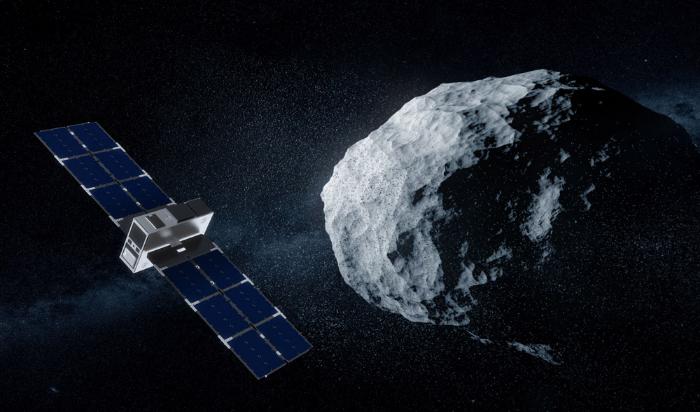
However, HERA isn’t traveling alone; it’s accompanied by two smaller satellites (CubeSats) that carry their own sets of equipment and will take readings that supplement those taken by HERA. The Milani minisatellite will use a hyperspectral camera and spectrometer to determine the elemental make-up of Dimorphos and Didymos.
This will also enable scientists to compare the composition of its surface to that of known meteorites and minerals, such as that of the DART crater and its ejecta. Milani also has an onboard analyzer calibrated to detect dust particles between 200 and 400 microinches (5 to 10 micrometers) in diameter. Scientists can use it to learn more about Dimorphos’ composition by studying the dust thrown up by the collision.
Juventas: First radar view into the interior of an asteroid
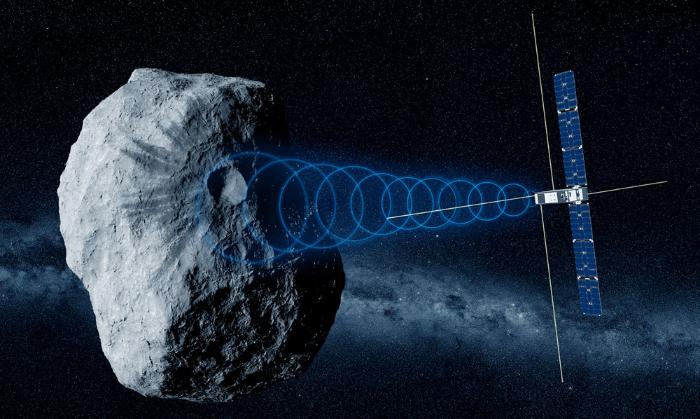
HERA’s companion CubeSat, Juventas, will be investigating the asteroids’ composition and dynamics up close. It is equipped with a miniature replica of the radar sensor used by ESA’s Rosetta comet mission to survey 67P/Churyumov–Gerasimenko, making it the smallest radar system ever sent into orbit. The Juventas radar system will carry out the same task at Didymos and Dimorphos. To do this, it will set up 4 radar antennas, each measuring 5 feet (1.5 meters) in length, and radiating radar waves with circular polarization. The incoming and outgoing signals from Dimorphos’ interior will be recorded and decoded simultaneously.
In order to get accurate readings, the tiny radar satellite Juventas will fly within 1.85 miles (3 kilometers) of Dimorphos at a slow enough speed to get high-resolution data despite the radar’s low power. The radar scan of an asteroid by Juventas will be the first of its kind which will greatly expand the understanding of asteroids. The reason for this mission is that the outside of an asteroid does not actually portray its interior accurately.
Determining whether Dimorphos is made of solid, compact rock or a loosely formed “pile of debris” will be crucial for future asteroid defense. This data, together with measurements of the DART deflection experiment will aid scientists in improving and adjusting the models and calculations used to plan such defensive operations to protect Earth from asteroids in the future.



